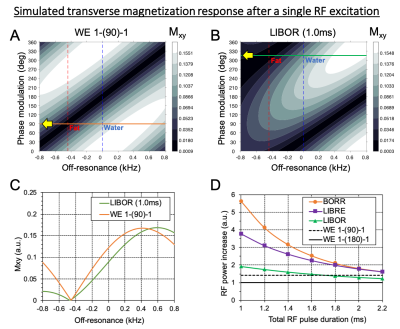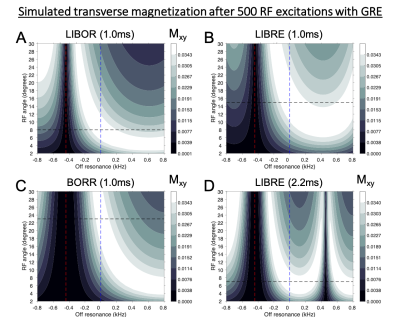1564
Fat-free MRI with fast and power-optimized off-resonant LIBOR pulses1Department of Diagnostic, Interventional and Pediatric Radiology (DIPR), Inselspital, Bern University Hospital, University of Bern, Bern, Switzerland, 2Translational Imaging Center, sitem-insel, Bern, Switzerland, 3Advanced Clinical Imaging Technology, Siemens Healthcare, Lausanne, Switzerland, 4Department of Radiology, Lausanne University Hospital (CHUV) and University of Lausanne (UNIL), Lausanne, Switzerland
Synopsis
Flexible off-resonant RF pulse designs such as LIBRE and BORR are inspired by conventional binomial 1-(180)-1 water excitation pulses and perform better in terms of fat suppression. To abbreviate scanning times, BORR and LIBRE pulse durations can be shortened by increasing the RF excitation frequency at the expense of increased RF power. To reduce RF power, we developed a novel off-resonant RF pulse design based on the conventional 1-(90)-1 water excitation pulse. LIBOR, compared with LIBRE and BORR, reduced the required RF power while maintaining short pulse durations and effective fat suppression in simulations, knee, and cardiac MRI at 3T.
Introduction
Flexible off-resonant RF pulse designs such as LIBRE1,2 and BORR3,4 are inspired by conventional binomial 1-180-1 water excitation (WE) pulses and perform better in terms of fat signal suppression. To achieve shorter scanning times, BORR and LIBRE pulse durations can be decreased by increasing the RF excitation frequency, which makes the RF pulse less efficient in exciting on-resonance water1,5. To mitigate this efficiency loss, the RF power needs to be increased to achieve the desired rotation of the water magnetization. Therefore, a decrease in pulse duration comes at the expense of increased RF power and RF energy deposits (SAR). This poses limits on the use and flexibility of off-resonant excitation pulses where short repetition times (TR) are required such as in bSSFP6. To reduce RF power and SAR, we propose a novel off-resonant RF pulse, LIBOR (Lipid Insensitive Binomial Off-Resonant pulse), which follows a similar concept as LIBRE and BORR, but is inspired by the conventional 1-(90)-1 WE pulse. The aim was to develop LIBOR and compare with LIBRE and BORR pulses of equivalent pulse duration. Differences in RF energy deposit and fat signal suppression were quantitatively compared in simulations, knee, and cardiac MRI at 3T.Methods
RF pulse design: Instead of waiting for a 180 degree phase evolution between water and fat, a 1-(90)-1 binomial WE pulse employs half the phase evolution and uses a phase-modulation on the second RF pulse to rotate fat magnetization back up to the longitudinal axis7,8. For LIBOR, following a similar principle, the off-resonance frequency of a BORR and LIBRE pulse1 was halved, and we sought to characterize the required phase-modulation to achieve fat suppression. Because of the excitation frequency decrease, the LIBOR pulse is by design more efficient in exciting water and requires a lower RF power.Simulations: Bloch equation simulations were performed as described before1,2 to compute the transverse magnetization response as function of off-resonance of 1) a LIBOR pulse (with 1.0ms pulse duration and various phase-modulations), 2) a LIBRE pulse (with 1.0ms5 and 2.2ms2 pulse duration), 3) a BORR pulse (with 1.0ms pulse duration), 4) and two conventional water excitation pulses (1-(90)-1 and 1-(180)-1). The LIBOR fat suppression bandwidths, and the efficiency of the different pulses, i.e. the required increase in power deposit relative to on-resonant pulses, were computed. These results informed on RF pulse and sequence parameters for subsequent MRI experiments
Experiments: LIBRE, BORR, and LIBOR RF pulses were implemented in a prototype ECG-triggered respiratory-self-navigated 3D golden angle radial GRE sequence2,9,10 with capability of tuning the RF pulse parameters from the user interface. MRI experiments were performed in a 3T clinical MRI scanner (MAGNETOM Prisma, Siemens Healthcare, Erlangen, Germany) in knees (n=2) and hearts (n=3) of volunteers following ethics protocols, with written and informed consent obtained from all participants. In cardiac scans, the acquisition window was maintained at 100ms per heartbeat, resulting in a 3D radial trajectory of 18 segments acquired per heartbeat (total: 547 heartbeats) for the 2.2ms LIBRE pulse and 23 segments per heartbeat (total: 424 heart beats) for the other pulses. Total amount of acquired k-space lines was the same for all scans (~10k). Cardiac images were reconstructed at the scanner. Signal-to-noise-ratio (SNR) was calculated in fat and muscle tissue compartments.
Results and discussion
Simulations experiments show excellent fat suppression with a bandwidth of 300Hz of the novel LIBOR pulse using a -45 degrees phase modulation, in comparison to a bandwidth of 130Hz of a conventional 1-(90)-1 pulse (Fig.1A-C). The LIBOR water excitation efficiency is higher compared with LIBRE and BORR which results in a lower required RF power to achieve identical rotation of the water magnetization (Fig.1D). A LIBOR pulse of 1.0ms reduced the RF power increase to 1.9 compared with LIBRE (3.8) and BORR (5.6) (Fig.1D). The simulated GRE signal confirms the different RF power requirements in terms of RF excitation angle increase (Fig.2), and demonstrates similar B1 behavior of the different pulses.In vivo, using the power adjusted RF pulses, nearly complete fat signal suppression was obtained in all cases (Fig.3A). However, LIBOR reduced the SAR to 0.0016mW/kg compared with 0.0083mW/kg (LIBRE) and 0.0191mW/kg (BORR), while maintaining short TR and scanning times (Fig.3A). SNR in fat and muscle tissue were similar for all pulses (Fig.3B). An in vivo check of the phase modulation corroborates the finding for -45 degrees for LIBOR (Fig.3C). Although not investigated in previous publications3,4, BORR works well at short pulse durations, and might be a good alternative for water excitation when SAR is not an issue.Free-breathing whole-heart MRI show that all pulses work equally well for large volume fat suppression (Fig.4). The SAR differences compared with the knee experiments are caused by ECG-triggering and the added vendor-provided T2-preparation module11.These results suggest that LIBOR may have superior performance compared with LIBRE when applied in non-ECG-triggered acquisition frameworks6.
Conclusion
A novel LIBOR RF pulse was developed that demonstrates robust fat suppression while maintaining short TR and reducing RF power compared with LIBRE and BORR pulses. These findings are especially interesting to address SAR problems encountered in 3D radial bSSFP sequences where fat suppression remains challenging, and this will be further investigated.Acknowledgements
The present study was funded by the Swiss National Science Foundation (grant number PCEFP2_194296, PZ00P3_167871), the Unil Bourse Pro-Femmes, the Emma Muschamp Foundation and the Swiss Heart Foundation.References
(1) Bastiaansen, J. A. M.; Stuber, M. Flexible Water Excitation for Fat-Free MRI at 3T Using Lipid Insensitive Binomial off-Resonant RF Excitation (LIBRE) Pulses. Magn Reson Med 2017. https://doi.org/10.1002/mrm.26965.
(2) Bastiaansen, J. A. M.; van Heeswijk, R. B.; Stuber, M.; Piccini, D. Noncontrast Free-Breathing Respiratory Self-Navigated Coronary Artery Cardiovascular Magnetic Resonance Angiography at 3 T Using Lipid Insensitive Binomial off-Resonant Excitation (LIBRE). J. Cardiovasc. Magn. Reson. 2019, 21 (1), 38. https://doi.org/10.1186/s12968-019-0543-6.
(3) Ye, Y.; Hu, J.; Haacke, E. M. Robust Selective Signal Suppression Using Binomial Off-Resonant Rectangular (BORR) Pulses. J Magn Reson Imaging 2014, 39 (1), 195–202. https://doi.org/10.1002/jmri.24149.
(4) Ye, Y.; Wu, Z.; Lewis, N. A.; Fan, Q.; Haacke, E. M. Retrobulbar Magnetic Resonance Angiography Using Binomial Off-Resonant Rectangular (BORR) Pulse. Magn Reson Med 2015, 74 (4), 1050–1056. https://doi.org/10.1002/mrm.25498.
(5) Colotti, R.; Omoumi, P.; Bonanno, G.; Ledoux, J.-B.; Heeswijk, R. B. van. Isotropic Three-Dimensional T2 Mapping of Knee Cartilage: Development and Validation. J. Magn. Reson. Imaging 2018, 47 (2), 362–371. https://doi.org/10.1002/jmri.25755.
(6) Masala, N.; Bastiaansen, J. A. M.; Sopra, L. D.; Roy, C. W.; Piccini, D.; Yerly, J.; Colotti, R.; Stuber, M. Free-Running 5D Coronary MR Angiography at 1.5T Using LIBRE Water Excitation Pulses. Magn. Reson. Med. 2020, 84 (3), 1470–1485. https://doi.org/10.1002/mrm.28221.
(7) Lin, H. Y.; Raman, S. V.; Chung, Y. C.; Simonetti, O. P. Rapid Phase-Modulated Water Excitation Steady-State Free Precession for Fat Suppressed Cine Cardiovascular MR. J Cardiovasc Magn Reson 2008, 10, 22. https://doi.org/10.1186/1532-429X-10-22.
(8) Thomasson, D.; Purdy, D.; Finn, J. P. Phase-Modulated Binomial RF Pulses for Fast Spectrally-Selective Musculoskeletal Imaging. Magn. Reson. Med. 1996, 35 (4), 563–568. https://doi.org/10.1002/mrm.1910350416.
(9) Piccini, D.; Littmann, A.; Nielles-Vallespin, S.; Zenge, M. O. Spiral Phyllotaxis: The Natural Way to Construct a 3D Radial Trajectory in MRI. Magn Reson Med 2011, 66 (4), 1049–1056. https://doi.org/10.1002/mrm.22898.
(10) Piccini, D.; Littmann, A.; Nielles-Vallespin, S.; Zenge, M. O. Respiratory Self-Navigation for Whole-Heart Bright-Blood Coronary MRI: Methods for Robust Isolation and Automatic Segmentation of the Blood Pool. Magn. Reson. Med. 2012, 68 (2), 571–579. https://doi.org/10.1002/mrm.23247.
(11) Kim, P.; Wendell, D.; Park, E.-A.; Kim, H.; Lee, W.; Rehwald, W. G. A Fat Suppressed Adiabatic T2-Preparation Module for 3T. J. Cardiovasc. Magn. Reson. 2013, 15 (1), E52. https://doi.org/10.1186/1532-429X-15-S1-E52.
Figures

(A,B) Comparison of Mxy of a 1-(90)-1 WE pulse with the LIBOR WE pulse after a single RF excitation of 10 degrees. A phase modulation of -45 degrees (equivalent to 315 degrees) results in fat suppression band around -440Hz. Fat suppression was defined as 10% of the maximum observed transverse magnetization (Mxy). Dashed red and blue lines indicate the resonance frequencies of fat and water.
(C) Mxy plots corresponding to the solid orange and green line (panel A& B).
(D) Required RF power increase with respect to conventional 1-(180)-1 water excitation as function of total RF pulse duration.


(A) Fat suppression in the knee is similar when comparing LIBOR with LIBRE and BORR pulses, while maintaining a short TR is maintained and reducing SAR.
(B) SNR of fat and muscle tissue. The slight increase in muscle SNR with the LIBRE (2.2ms) pulse may be related to the longer TR used in this experiment, or a decrease in the standard deviation of the noise due to the RF excitation pulse being less off-resonant.
(C) SNR of fat and muscle corroborate the simulation results that a phase modulation of -45 degrees (equivalent to 315 degrees) should be applied to the novel LIBOR pulse.
